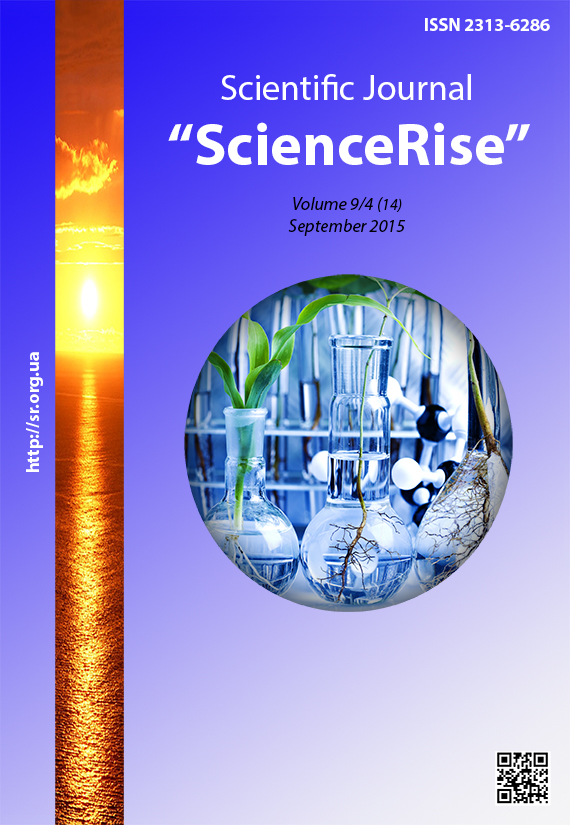Improvement of classification of real estate of railway transport
DOI:
https://doi.org/10.15587/2313-8416.2015.50759Keywords:
tuberculosis, model, treatment, dosage, side effects, izonazyd, pyridoxine, group, experiment, changeAbstract
It was proposed a method of determining the optimum ratio of doses of the most pronounced therapeutic effect and minimal side effects.
The aim of the study was to conduct morphological evaluation of lesions of internal organs (lungs, liver, kidneys, spleen) after treatment of experimental tuberculosis of guinea pigs different ratios of doses of isoniazid and pyridoxine hydro- chloride.
Methods: 50 guinea pigs infection dose of 1 mg Mycobacterium death porpoises from generalized tuberculosis occurs after an average of 45 days, at infection doses of 0.1–0.01 mg – after 60–70 days. Smaller doses of 0.0001 and 0.000001 mg cause chronic disease that ends in death.
Results: The optimal therapeutic effect is obtained by treating animals with experimental tuberculosis isoniazid at a dose of 32 mg/kg of vitamin B6 and
5 mg/kg body weight of the animal, thus completely disappeared phenomenon specific inflammation in the lungs, liver, kidneys and spleen. This phenomenon also disappeared perifocal nonspecific inflammation. Disappeared dystrophic and necrotic changes in the studied organs.
Conclusions: In the experiment Shuttle "INH – pyridoxine hydrochloride" 32 and 5 mg/kg respectively leads to a lack of specific and non-specific manifestations of inflammation in the lungs, liver, kidneys and spleen
References
Korneev, A. L., Golyshevskaja, V. I., Sevast'janova, Je. V., Safonova, S. G., Puzanov, V. A. (1999). Biologicheskie svojstva laboratornyh shtammov i klinicheskih izoljatov mikobakterij, polirezistentnyh k protivotuberkuleznym. Problemy tuberkuleza, 2, 44–47.
Feshhenko, Ju. I., Mel'nyk, V. M., Kobljans'ka, A. V. (2003). Himiorezystentnyy Tuberculosis. Kyiv: Health, 136.
Rüsch-Gerdes, S. (1999). Epidemiology of resistant tuberculosis in Europe. Infection, 27 (S2), S17–S18. doi: 10.1007/bf02561664
Korovnyk, V. S., Bondalevych, L. V., Leskovec, T. M., Bybyk, Y. L. (1998). Factors influencing the effectiveness of treatment of patients with pulmonary tuberculosis, drug-resistant mycobacteria secrete.VI Congress of TB specialists in Belarus. Minsk, 272–275.
Khomenko, A. G. (Ed.) (1992). Chemotherapy of pulmonary tuberculosis: Method recommendations. Moscow, 15.
Korneev, A. L., Golyshevskaja, V. Y., Sevast'janova, E. V., Safonova, S. G., Puzanov, V. A. (1999). Biological properties of laboratory strains and clinical isolates of mycobacteria, MDR TB drug. Problems of tuberculosis, 2, 44–47.
Treatment of tuberculosis (1997). Guidelines for national programs. 2nd ed. Geneva: VOZ.
Moroz, A. M. (1996). Tuberculosis: a disease of the present and the future. Russian med. Journal, 5, 55–57.
Feshenko, Y. I. (1996). Modern chemotherapy of lung tuberculosis. Treatment and diagnosis, 2, 34–36.
Chernyshenko, L. F., Kymenko, M. T. (1998). Microbiological tuberculosis diagnostics. Laboratory diagnostics, 1, 39–42.
Chapman, S. W., Henderson, H. M. (1994). New and emerging pathogens – multiply resistant Mycobacterium tuberculosis. Current Opinion in Infectious Diseases, 7 (2), 231–237. doi: 10.1097/00001432-199404000-00016
Downloads
Published
Issue
Section
License
Copyright (c) 2015 Людмила Володимирівна Гайова

This work is licensed under a Creative Commons Attribution 4.0 International License.
Our journal abides by the Creative Commons CC BY copyright rights and permissions for open access journals.
Authors, who are published in this journal, agree to the following conditions:
1. The authors reserve the right to authorship of the work and pass the first publication right of this work to the journal under the terms of a Creative Commons CC BY, which allows others to freely distribute the published research with the obligatory reference to the authors of the original work and the first publication of the work in this journal.
2. The authors have the right to conclude separate supplement agreements that relate to non-exclusive work distribution in the form in which it has been published by the journal (for example, to upload the work to the online storage of the journal or publish it as part of a monograph), provided that the reference to the first publication of the work in this journal is included.

